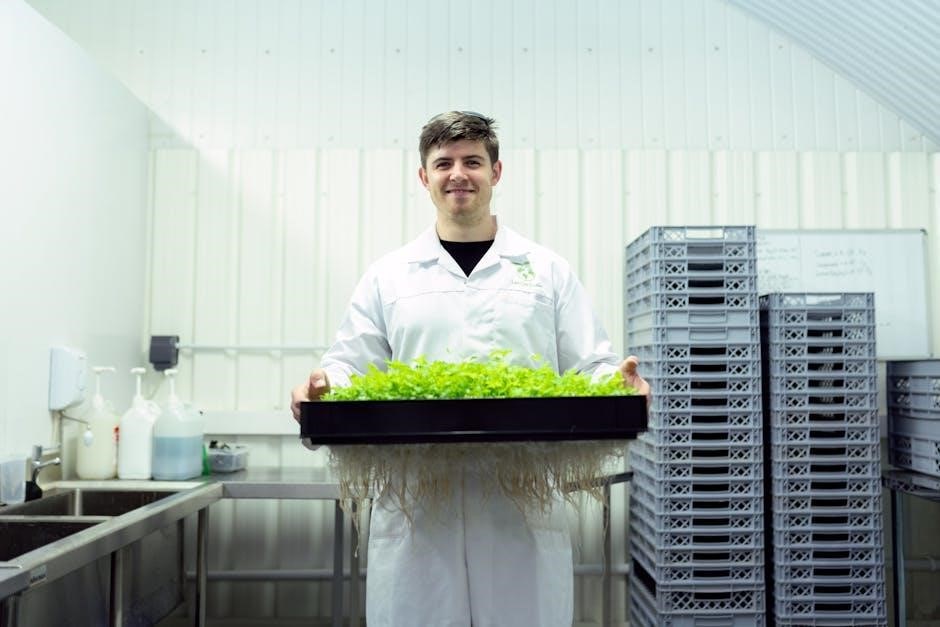
This lab explores ecological succession, a gradual process where ecosystems change over time. Students observe and predict future ecosystem states through hands-on activities and data analysis;
1.1 Definition of Ecological Succession
Ecological succession is the gradual and predictable process through which ecosystems change and develop over time. It involves shifts in species composition and community structure, driven by environmental factors. This process occurs in areas with or without pre-existing soil, leading to the establishment of new plant and animal communities. Succession is a dynamic and continuous process, shaping the biodiversity and functionality of ecosystems over generations.
1.2 Importance of Studying Ecological Succession
Studying ecological succession is crucial for understanding ecosystem dynamics and biodiversity. It provides insights into how communities recover after disturbances like fires or human impact. This knowledge aids in conservation, restoration, and sustainable land management. By analyzing succession patterns, scientists can predict future ecosystem changes and develop strategies to mitigate environmental challenges, ensuring healthier and more resilient ecosystems for future generations. This understanding is vital for balancing human activities with ecological preservation and restoration efforts.
1.3 Overview of the Lab Activity
This lab activity introduces students to ecological succession through hands-on observations and simulations. Participants explore how ecosystems change over time, focusing on plant species colonization and biodiversity shifts. The activity involves simulating succession in areas like abandoned hay fields, observing changes over 5–100 years. Students collect data on species composition and analyze patterns, gaining insights into succession stages and factors influencing ecosystem development. This experiential approach helps students connect theoretical concepts with real-world ecological processes.
Key Concepts in Ecological Succession
Ecological succession involves the gradual replacement of species, with primary succession occurring in lifeless areas and secondary in areas with existing soil and vegetation. It progresses through pioneer to climax stages, shaped by environmental factors and disturbances.
2.1 Primary vs. Secondary Succession
Primary succession occurs in lifeless areas with no soil, such as after a volcanic eruption, beginning with pioneer species like lichens and mosses. Secondary succession happens in areas with existing soil, such as abandoned fields or burned forests, starting with grasses and shrubs. Both processes involve species replacement, but secondary succession is faster due to the presence of soil and seed banks. Understanding these differences is crucial for analyzing ecosystem recovery and management strategies in various environmental contexts.
2.2 Stages of Ecological Succession
Ecological succession progresses through distinct stages, beginning with pioneer species colonizing barren areas. These species, like mosses and lichens, initiate soil development. As soil improves, larger plants such as grasses and shrubs dominate, increasing biodiversity; Over time, trees replace earlier vegetation, forming a forest ecosystem. Finally, a climax community emerges, characterized by stable species composition and maximum biodiversity. Each stage builds on the previous one, with species replacements driven by competition and environmental changes, ultimately shaping the ecosystem’s structure and function over time.
2.3 Factors Influencing Succession
Several factors shape the trajectory of ecological succession, including environmental conditions, biotic interactions, and disturbances. Climate, soil quality, and topography significantly influence the rate and direction of succession. Biotic factors like competition, predation, and symbiosis also play a crucial role. Disturbances such as fires, floods, or human activities can reset or alter the succession process. Additionally, the availability of resources like light, water, and nutrients determines which species dominate at each stage, ultimately shaping the ecosystem’s structure and function over time.

Lab Materials and Setup
- Soil samples from different stages of succession
- Vegetation data collection tools (e.g., quadrat frames)
- Measuring instruments (e.g., rulers, scales)
- Species identification guides
- Lab notebooks and data sheets
- Microscopes for observing small organisms
- Computers for data analysis
3.1 Materials Required for the Lab
The following materials are essential for conducting the ecological succession lab:
- Soil samples from areas representing different stages of succession
- Vegetation data collection tools (e.g., quadrat frames, measuring tapes)
- Species identification guides or charts
- Lab notebooks and data sheets for recording observations
- Microscopes for analyzing soil and plant samples
- Computers or tablets for data analysis and graph creation
- Optional: Simulation models or software for succession visualization
These materials enable students to observe, measure, and analyze the changes in ecosystems over time, aligning with lab objectives.
3.2 Experimental Design and Setup
The lab involves simulating ecological succession by observing changes in plant communities over time. Students prepare multiple experimental plots, each representing different stages of succession. Primary succession plots start with bare soil, while secondary succession plots use existing soil. Vegetation samples are collected and analyzed to document species composition. Tools like quadrat frames are used to measure biodiversity. Controlled variables, such as nutrient levels, are applied to test their impact. Photographs and sketches are taken to record initial observations, forming a baseline for future comparisons. This setup allows students to witness and document ecological changes systematically.
Observations and Data Collection
Students observe and record changes in plant species over time, measuring biodiversity and noting shifts in community composition using tools like quadrat frames and species checklists.
4.1 Measuring Biodiversity Over Time
Measuring biodiversity over time involves tracking changes in species diversity and abundance during ecological succession. Students use methods like quadrat frames and species checklists to collect data. By observing and recording plant and animal populations at regular intervals, they can identify patterns in community composition. Data collection includes counting individual species, noting new arrivals, and documenting species extinctions. This process helps analyze how biodiversity shifts as ecosystems mature. Graphs and charts are often used to visualize these changes, making trends in succession more apparent. Regular sampling ensures consistent and reliable data for analysis.
4.2 Recording Changes in Species Composition
Recording changes in species composition involves documenting the arrival, growth, and decline of plant and animal species over time. Students use field notes, photographs, and data logs to track these changes. By identifying and counting species at each stage, they can create a timeline of succession. Tools like species checklists and quadrat frames help ensure accuracy. Data is organized into charts or spreadsheets to visualize shifts in community structure. This process highlights how species diversity and dominance change as ecosystems mature and stabilize.
Data Analysis and Interpretation
Data analysis involves identifying trends in biodiversity and species dominance over time. Graphs and charts are used to visualize succession stages, aiding in clear interpretation of results.
5.1 Graphical Representation of Succession Stages
Graphical representations, such as bar graphs or line charts, are used to illustrate biodiversity changes and species dominance over time. These visuals help identify patterns in succession, such as the increase in tree species after 50 years. Pie charts can show shifts in community composition, while timelines depict the progression of dominant species. By plotting data, students can clearly observe how ecosystems evolve, making complex succession processes more accessible and easier to interpret for deeper understanding and analysis.
5.2 Interpreting Trends in Species Dominance
Analyzing data reveals shifts in species dominance over time, highlighting how pioneer species give way to climax communities. Early stages show rapid growth of hardy plants, while later stages reflect taller tree dominance. This transition indicates ecosystem maturity and competition for resources. By interpreting these trends, students can understand how environmental factors influence succession. The lab answer key provides insights into these patterns, enabling students to draw conclusions about biodiversity and ecosystem stability, which are vital for conservation and management practices.

Discussion and Implications
Ecological succession highlights how disturbances reset ecosystems, influencing biodiversity and species dominance. Understanding these dynamics aids in developing sustainable management practices to restore and preserve ecosystems effectively.
6.1 The Role of Disturbances in Succession
Disturbances, such as fires or floods, reset ecosystems, triggering ecological succession. These events remove existing vegetation, creating opportunities for new species to colonize. Primary succession occurs in lifeless areas, while secondary succession happens in places with remaining soil. Disturbances influence biodiversity by altering species composition and dominance. They are natural drivers of ecosystem change, ensuring a dynamic balance. Understanding their role is crucial for predicting succession patterns and managing ecosystems effectively.
6.2 Implications for Ecosystem Management
Understanding ecological succession is vital for effective ecosystem management. It informs conservation strategies, restoration efforts, and sustainable land-use practices. By predicting succession patterns, managers can maintain biodiversity and ecosystem resilience. Succession insights also guide reforestation and wildlife habitat restoration. Balancing human activities with natural processes ensures long-term ecosystem health and sustainability. This knowledge aids in mitigating the impacts of disturbances and climate change, promoting harmonious coexistence between human needs and environmental integrity.
The lab demonstrated ecological succession’s role in shaping ecosystems, emphasizing its importance in conservation and sustainable management to maintain biodiversity and ecosystem health over time.
7;1 Summary of Key Findings
Evidence from the lab demonstrates that ecological succession is a predictable process of ecosystem change, with species composition evolving over time. Initial stages show colonization by pioneer species, followed by gradual replacement with more complex plant and animal communities. Environmental factors such as soil quality, light exposure, and disturbances significantly influence the pace and direction of succession. Data analysis revealed clear patterns in species dominance and biodiversity shifts, highlighting the importance of understanding succession for ecosystem management and conservation strategies.
7.2 Applications of Succession Knowledge
Understanding ecological succession is crucial for effective ecosystem restoration and conservation. It informs strategies for reforestation, wildlife habitat creation, and soil recovery. Succession principles guide land managers in predicting and addressing environmental changes, such as climate shifts or invasive species. This knowledge also aids in developing sustainable agriculture practices, ensuring long-term productivity. By applying succession concepts, scientists can better mitigate human impacts on natural ecosystems, promoting biodiversity and ecological resilience in various environments and scenarios.

Ecological Succession Lab Answer Key
This section provides answers to common lab questions, including interpretations of ecological succession stages, species dominance trends, and experimental data analysis for accurate understanding.
8.1 Common Questions and Answers
- What is ecological succession? It is the process of ecosystem change over time, involving shifts in species composition and community structure.
- How is biodiversity measured in succession labs? Biodiversity is assessed by counting species and their abundance, often using indices like Simpson or Shannon-Wiener.
- What distinguishes primary from secondary succession? Primary occurs in lifeless areas (e.g., after lava flows), while secondary happens in areas with existing soil (e.g., after fires).
- How do nutrients affect succession? Added nutrients can accelerate succession by favoring fast-growing species, altering community dynamics and diversity.
8.2 Interpreting Lab Results
Interpreting lab results involves analyzing biodiversity trends, species composition changes, and succession stages over time. Observations should be compared to theoretical expectations, such as the gradual replacement of pioneer species by climax communities. Key factors like nutrient availability, disturbance, and initial conditions must be considered. Graphical representations, such as line graphs showing species abundance, help visualize ecosystem development. These interpretations provide insights into how ecosystems recover and evolve, supporting broader ecological principles and management strategies.

Additional Resources
Explore these resources for deeper insights:
– Ecological Succession: A Comprehensive Guide for detailed explanations.
– Online simulations like Virtual Ecosystem Lab for interactive learning.
These tools enhance understanding and practical application of succession concepts.
9.1 Recommended Reading
For a deeper understanding of ecological succession, explore these resources:
– Ecological Succession: A Comprehensive Guide by Jane Smith, offering detailed insights into succession processes.
– Lab Manual for Ecological Succession Studies, providing practical experiments and data analysis techniques.
– Environmental Science: Key Concepts, covering succession principles and their real-world applications.
These texts enrich theoretical knowledge and practical skills, ensuring a well-rounded understanding of ecological dynamics.
9.2 Online Simulations and Tools
Enhance your learning with these online resources:
– EcoSuccession Simulator: A virtual lab modeling primary and secondary succession processes.
– Succession Timeline Interactive: Visualize changes in species composition over time.
– Ecological Succession Game: Engage in a simulation where decisions impact ecosystem development.
These tools provide interactive and immersive experiences, making complex concepts accessible and engaging for students and educators alike.